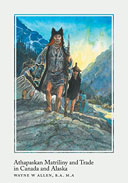
 |
There is a plethora of buried theses out there because after most graduate students complete their hard work and training, they move on. Allen’s thesis was one of them… until he decided to publish it in the form of a fascinating social anthropology book.
The Athapaskans, indigenous peoples of the western subarctic regions of North America, get little attention in history books. Most North American readers probably have never heard of these indigenous tribes, though they are plentiful in Canada and Alaska especially. How did they survive? What was their social structure and why? How did different Athapaskan groups differ from one another as they migrated and traded with others across North America?
While our society takes for granted that married couples decide for themselves where to reside and what family alliances to keep, indigenous civilizations sometimes had prescribed groups, moieties, with which they allied. New brides stayed with her parents, and their spouses were brought into the clan in some areas. Marriages helped solidify trade practices, and so who married whom was more dictated than today. "This pattern of intermarriage being associated with trade was extended by the interior peoples to their neighbors farther north," according to studies from the 1950s.
Years of painstaking research is packed into this study of the Athapaskan people, their trade practices, and social structure. Drawings and maps illustrating trade routes and social systems help clarify the author's well-documented points and make this academic work more interesting and readable to the layperson. The book is expertly written, well-organized, and fascinating for anyone wanting to learn more about cultural anthropology. This thesis does not belong buried in the rubble. Readers come away further educated and with more questions about the advantages and disadvantages of different social structures and norms.